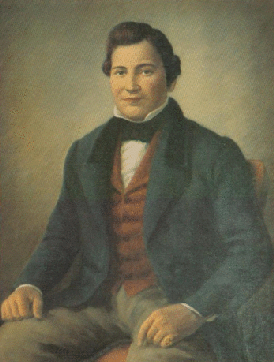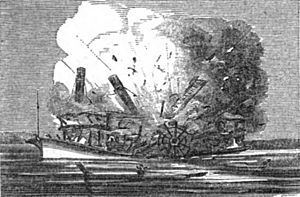Joseph Vann facts for kids
Quick facts for kids
Joseph Vann
|
|
|---|---|

Joseph "Rich Joe" Vann
|
|
| Born | February 11, 1798 Spring Place, Georgia
|
| Died | October 23, 1844 near Louisville, Kentucky
|
| Occupation | Chief Vann House Owner, Cherokee Leader |
| Spouse(s) | Jennie Springston, Polly Blackburn |
Joseph H. Vann (born February 11, 1798 – died October 23, 1844) was an important Cherokee leader. He was also a successful businessman and a large-scale farmer in Georgia, Tennessee, and later in Indian Territory. He owned many farms, businesses, and even steamboats. In 1837, he moved with many Cherokee people to Indian Territory. He knew they had to move because of the government's Indian Removal policy. He built his businesses along big rivers like the Tennessee, Ohio, Mississippi, and Arkansas.
Contents
Early Life and Family History
Joseph H. Vann was born in Spring Place, Georgia, on February 11, 1798. His parents were James Vann and Nannie Brown. Both of his parents were Cherokee people with some European family history. Joseph's father, James Vann, was a powerful chief in the Cherokee Nation. He had several wives and children. The Cherokee were known as one of the Five Civilized Tribes. This was because they had adopted some European-American ways, often from traders who married into their families.
Joseph's grandparents on his father's side were Joseph Vann, a Scottish trader, and Mary Christiana (Wah-Li or Wa-wli Vann), a Cherokee woman. Young Joseph was his father's favorite child. He was meant to inherit most of his father's property and wealth.
When Joseph was 11, his father, James, was killed in 1809. This happened at Buffington's Tavern in what is now Forsyth County, Georgia. James Vann had wanted Joseph to inherit all his wealth. However, Cherokee law said that the family home should go to his wife, Peggy. His other belongings and property were to be divided among his children.
Eventually, the Cherokee Council agreed to let Joseph inherit his father's wealth, as his father had wished. This included about 2,000 acres (8.1 km2) of land, trading posts, river ferries, and the Vann House in Spring Place, Georgia. Joseph also inherited his father's gold. He deposited over $200,000 in gold in a bank in Tennessee.
Facing Indian Removal
President Andrew Jackson helped pass the Indian Removal Act of 1830. This law allowed the government to force Native American tribes to move to new lands west of the Mississippi River. In exchange, they had to give up their lands in the Southeast. This was so European-American farmers could develop the land. In 1834, Joseph Vann was forced to leave his father's Georgia mansion, "Diamond Hill." This was part of the removal process. He then moved his large family and businesses to Tennessee. By this time, he had two wives and several children.
Vann started a large farm on the Tennessee River. It was near the mouth of Wolftever Creek. This area became a settlement called Vann's Town. Later, it became the site of Harrison, Tennessee, and then Harrison Bay State Park. Joseph became known as 'Rich Joe' Vann because of his success.
Moving to Indian Territory
In 1837, before the main Cherokee Removal, Vann helped many Cherokee people move. He transported a few hundred Cherokee men, women, and children. They also brought their enslaved African-American people (including 200 of his own) and horses. They traveled on flat boats to Webbers Falls in Indian Territory. There, Vann started a new farm. He directed enslaved people to build a copy of his old Georgia mansion. This building was later destroyed during the American Civil War. Vann also grew his steamboat business. His boats traveled on rivers that flowed into the Mississippi River and went all the way to New Orleans.
Escape Attempt by Enslaved People in 1842
In 1842, about 20 to 25 enslaved people belonging to Joseph Vann, Lewis Ross, and other wealthy Cherokee at Webbers Falls tried to escape. They took guns and horses. They hoped to reach Mexico to gain their freedom. They picked up 10 more people seeking freedom in Creek territory. A small group of people chasing them caught or killed 14 of the escapees. The rest continued south.
Soon, a group of 100 armed Cherokee men, organized by the Cherokee Council, recaptured them. Five of the people who had tried to escape were killed. This happened because they had killed two slave catchers they met while trying to free an enslaved family. Vann made his remaining enslaved people work as crew members on his steamboat. He named the boat Lucy Walker after his favorite race horse.

On October 23, 1844, the steamboat Lucy Walker left Louisville, Kentucky. It was heading for New Orleans. Below New Albany, Indiana, the boat was destroyed when one or more of its boilers exploded. Most of the people on board, including the owner and captain that day, Joseph Vann, were killed.
See also

